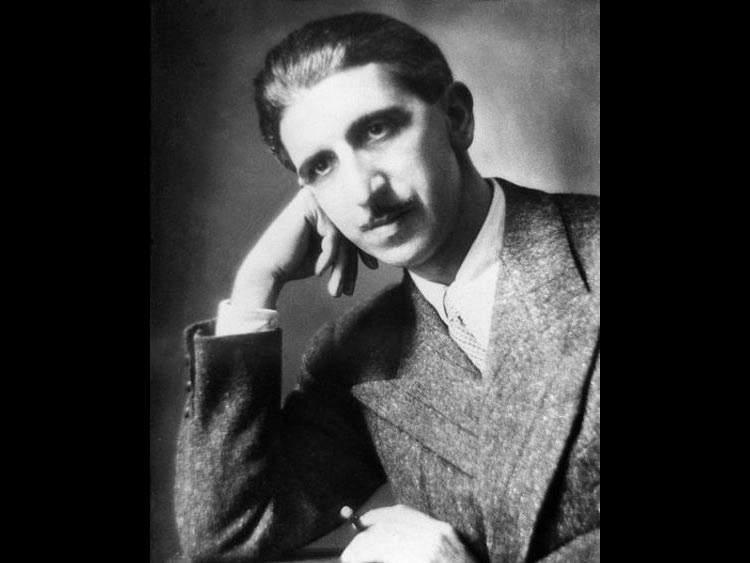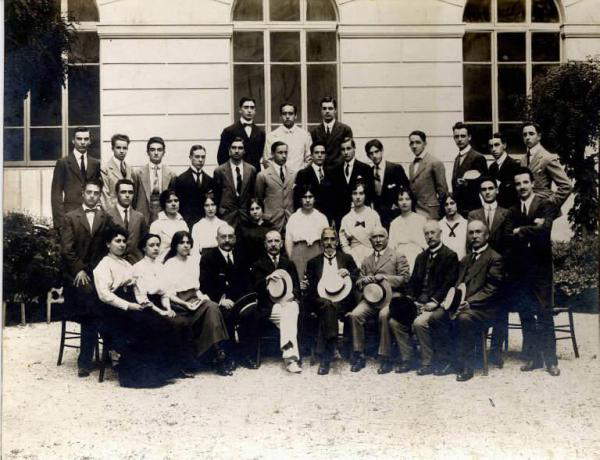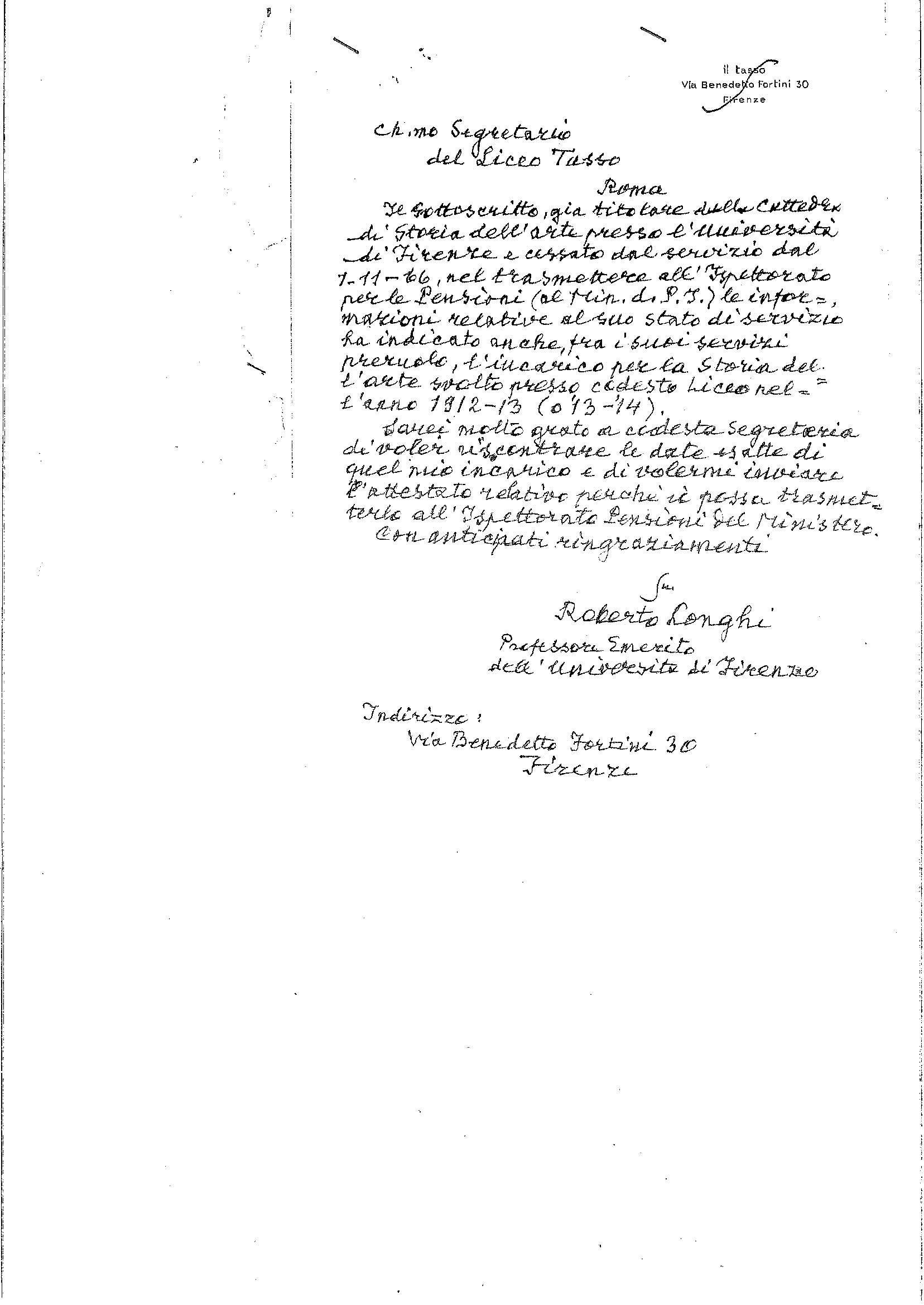We often read that between 1912 and 1914 Roberto Longhi taught art history at the Visconti High School, which is still based in the same square as the Jesuit Collegio Romano where the Ministry of Cultural Heritage is located, and at the Liceo Tasso in the Rione Ludovisi. And we also read that he had among his students Giuseppe Bottai and that also there he met another of his students, Lucia Lo Presti (who later assumed the non de plume of Anna Banti), his future wife. But in which of the two high schools?
An unpublished letter from Longhi that is published here for the first time - a letter that I owe to the courtesy of the current Dean of Tasso, Prof. Paolo Pedullà - proves that Longhi was incardinated at Tasso. In that letter, undated but which must date back to around 1966, when Longhi left the University of Florence due to age limit, the great art historian in fact asks the then dean of Tasso for a certificate of service for retirement purposes: incidentally, in the early twentieth century History of Art was still an experimental subject, what explains Longhi’s presence at both Visconti and Tasso. While a rare photo from 1914 of the senior class at Tasso documents among the students, Bottai and his future wife, Cornelia Ciocca, and also Anna Lopresti, aka “Anna Banti.”


p.s.
As is often said, Bottai was an “anomalous fascist”i. Minister of National Education, to him we owe the promulgation in 1939 of an organic body of laws pertaining to the preservation of the country’s artistic heritage: among them, l. no. 1089, “Protection of things of historical and artistic interest,” l. no. 1497, “Protection of natural and scenic beauty,” and l. 1240, “Creation of the Central Institute for Restoration at the Ministry of National Education,” the first institute of its kind put in place in the world thanks to a very happy intuition of Cesare Brandi and Giulio Carlo Arganii.
Alongside Bottai was Giulio Carlo Argan, who played the role of “gray eminence,” as Antonio Paolucciiii writes, and a distracted Roberto Longhi, who had been charged with organizing a catalog of our heritage, as he did neither then nor after the fall of Fascism. Distracted, because intelligent not to understand that the undertaking was immense and lacking in the future compared to the level of studies then. But also of today, since in 1975 a special “Central Institute of the Catalogue” was founded, which to date, 2022, thus 47 years after its establishment, still has not completed its task. Nor is this the place to recount the distressing affair of the failure to catalog our artistic heritage, the one at the root of the enormous cultural backwardness in the action of protection.

Ch.mo Secretary
of the Liceo Tasso
Rome
The undersigned, former holder of the Chair
of History of Art at the University
of Florence and ceased to serve as of
7-11-66, in transmitting to the Inspectorate
for Pensions (to the Min. d. P.I.) the infor=
mation regarding his service record
also indicated, among his service
prerole, the assignment for the History of=
art performed at this high school in=
the year 1912-1913 (or ’13-’14).
I would be very grateful to your Secretariat
to find the exact dates of
that assignment of mine and be willing to send me
the relevant certificate so that it can be transmitted=
ter it to the Ministry’s Pension Inspectorate.
With anticipated thanks,
His
Roberto Longhi
Professor Emeritus
of the University of Florence
i On Bottai’s cultural role in the Italy of those years see A. Masi, Giuseppe Bottai: from Futurism to the 2 percent law, Introd. to G. Bottai, La politica delle arti. Scritti 1918-1943, ed. by A.M., Rome, Editalia,1992, pp. 5-56.
ii For a history of the founding of the icr see, G.C. Argan, La creazione dell’Istituto centrale del restauro, interview collected by M. Serio, Rome, F.lli Palombi, 1989. For the record, I would add that already the Royal Decree No. 3164 of December 31, 1923, “Nuovo ordinamento delle Soprintendenze alle opere di Antichità e Arte,” in Art. 29 established “in Rome a Cabinet for research on the techniques of Restoration of objects of Antiquity and Art, to which restoration works of particular importance may be entrusted by the Institutes of Antiquity and Art”; while in Art. 30 it established “in Rome a Cabinet for the study of techniques for the conservation and restoration of paintings.” Needless to add how the law then remained a dead letter. I recall that the same 1939 saw the publication of l. Feb. 2 No. 374 “Regulations for the compulsory delivery of copies of printed matter and publications”; l. Feb. 2 No. 467 “Reorganization of the State Record Library”; l. May 22 nr. 823 “Reorganization of the Superintendence of Antiquities and Art”; l. Dec. 22 nr. 2006 “New Organization of State Archives.” On the legislative production of protection of the year 1939 so Tommaso Alibrandi and Piergiorgio Ferri: “The organic laws adopted in 1939, due to the immediate occurrence of the world conflict, had not practically received application testing. With these legislative instruments, however, the purposes of protection were to be fulfilled in the Italian events of post-war reconstruction and the subsequent period of impetuous economic-social development”(I beni culturali e ambientali, collaboratiz. by I. Alibrandi, Milan, Giuffrè, 19953, “Profilo storico della legislazione italiana,” pp. 3-44, with citation p. 9)
iii A. Paolucci, Ricordo di un Maestro, Roberto Longhi, in Longhi-Brandi: convergenze, divergenze, Atti dell’incontro di studio presso la Fondazione Longhi (Firenze 27 magg. 2008), a c. di M. C. Bandera & G. Basile, il prato, Saonara (Padova) 2010, pp. 279-284., riere ra", Apr. 10, 2013, p. 40o pili re applicativa ito i territori ak confine fra Molise e pug
Warning: the translation into English of the original Italian article was created using automatic tools. We undertake to review all articles, but we do not guarantee the total absence of inaccuracies in the translation due to the program. You can find the original by clicking on the ITA button. If you find any mistake,please contact us.